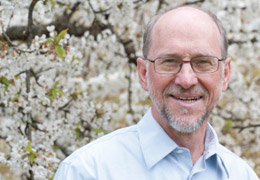
Dan Arp steps up to head OSU’s College of Agricultural Sciences
This story begins with a boy and a chemistry set in the basement of a Nebraska farmhouse.
“I guess I’m lucky I didn’t blow up the place,” laughs Dan Arp, who was that farm boy and is now the new dean of OSU’s College of Agricultural Sciences.
That chemistry set ignited a love of learning that has characterized Arp’s life and career. Growing up in 4-H, Arp explored projects from animal science to electronics that eventually earned him recognition and a scholarship to the University of Nebraska. There, Arp pursued his fascination with chemistry and the chemical building blocks of life on Earth.
Earning his PhD in biochemistry from the University of Wisconsin, Arp explored the detailed mechanisms of nitrification and the role of microorganisms in oxidizing ammonia. New technologies associated with genomics helped Arp see how bacteria can affect nitrogen in the soil, with impact on agricultural systems, bioremediation, and renewable energy.
Such discoveries thrilled him. “But eventually, I was thrilled even more by witnessing my students and younger colleagues make discoveries of their own,” Arp said. His love of learning became their love of learning.
Arp joined OSU’s College of Agricultural Sciences in 1990, eventually heading the department of botany and plant pathology where he earned the honor of “distinguished professor.” In 2008, he was named dean of the University Honors College, where he worked closely with students to enhance their learning experience.
Now, as the Reub Long Dean of Agricultural Sciences and director of the Oregon Agricultural Experiment Station at OSU, Arp takes over from former dean Sonny Ramaswamy, who was named by President Obama to lead the National Institute of Food and Agriculture in Washington, D.C.
Ramaswamy to lead top food and agriculture agency
Sonny Ramaswamy has left his position as dean of the College of Agricultural Sciences to lead the National Institute of Food and Agriculture (NIFA) in Washington, DC.
NIFA is the lead agency within the U.S. Department of Agriculture that supports research, education, and extension programs in the nation’s land-grant universities and partner organizations.
Ramaswamy joined Oregon State in 2009 and led the College during a time of decreasing state investments and a need for increasing extramural support for research and teaching. During his tenure, OSU’s agricultural research programs grew to almost $60 million in grants and contracts. Private support for the College and student programs grew to $77 million.
“Three concepts—preeminence, purpose, impact—defined our work at the college and the Experiment Station,” said Ramaswamy. Among many new initiatives begun under his leadership, he was especially proud of OSU’s Leadership Academy, a program for undergraduates that helps develop career-ready skills in leadership and communications.
A purple tomato as black as an eggplant
Indigo Rose, the world’s first tomato variety with purple anthocyanins, was released commercially this year by the vegetable breeding program at Oregon State University.
“The purple color is extraordinary,” said Jim Myers, who heads the vegetable breeding program. “It has a good balance of sugars and acids and tastes just like a tomato.” (Anthocyanins are essentially tasteless.)
The new tomato is released as an open pollinated variety, and as such, seed saved from self-pollinated plants will grow true and not produce hybrids. “It’s also important to know that these tomatoes are not GMO,” Myers said. “Genetic engineering techniques are never used to develop these lines.”
From Russia, with Love

- This western gray whale is from the same population as Varvara, near Sakhalin Island off Russia’s east coast. Photo by Craig Hayslip, OSU Marine Mammal Institute.
Scientists are tracking the migration of a rare western gray whale they’ve named “Varvara” as she makes her way up the west coast of North America, presumably en route to her home near Sakhalin Island off Russia’s east coast.
Outfitted with a small tracking device, Varvara is providing the first documentation that critically endangered western gray whales travel to Baja California, where each winter the more common eastern gray whales mingle and mate.
Varvara clearly was mingling. She visited three different lagoons on the Pacific side of the Baja peninsula, lagoons known to be calving and breeding grounds for eastern gray whales.
“She did not calve for sure, or she would have stayed in one place for four to eight weeks as the calf grew and gained strength,” said Bruce Mate, director of the Marine Mammal Institute at Oregon State University and a lead scientist in this multinational whale research. “It’s more likely that she might have been breeding this year, spending time around the lagoons where breeding activity is common.”
Mate should know. He pioneered the development of satellite-monitored radio tags to study the movements and critical habitats of free-ranging whales around the world. In 2010, Mate and his team of American and Russian scientists followed another western gray whale, nicknamed “Flex,” as it journeyed across the Bering Sea and down to Oregon, marking the first documentation of a western gray whale in the eastern Pacific. The scientists returned to Sakhalin Island in 2011 to tag six more western gray whales, including Varvara, whose tag has lasted all through her journey to Mexico and is still transmitting, 8,000 miles later.
Varvara was first sighted as a calf in 2003 and has a reputation for being particularly playful during small boat encounters.
So, did she or didn’t she?
Time will tell. Until then, research continues by A.N. Severtsov Institute of Ecology and Evolution of the Russian Academy of Sciences and OSU Marine Mammal Institute in collaboration with the U.S. National Marine Fisheries Service, Kronotsky State Nature Biosphere Reserve, and the Kamchatka Branch of the Pacific Institute of Geography.
Learn more about Varvara and other tagged whales on OSU's Marine Mammal Institute website.



